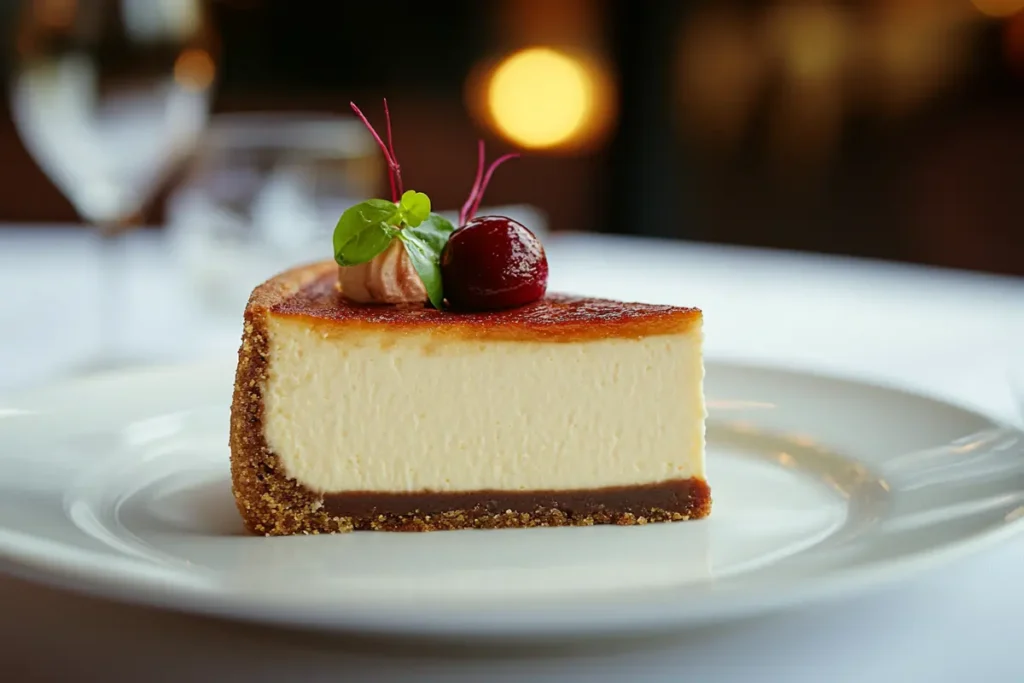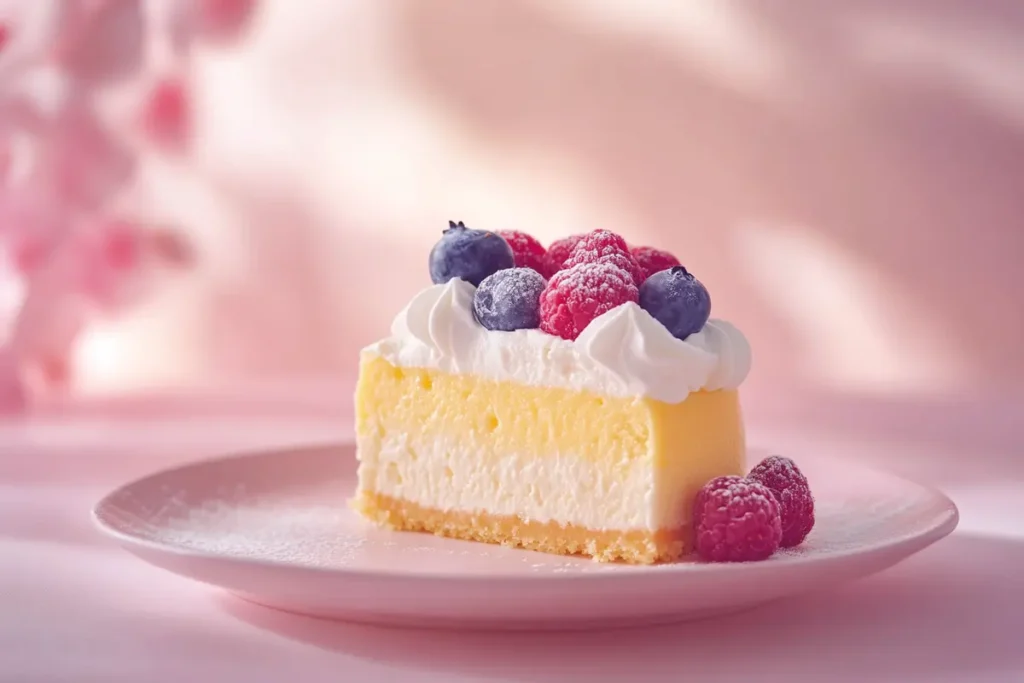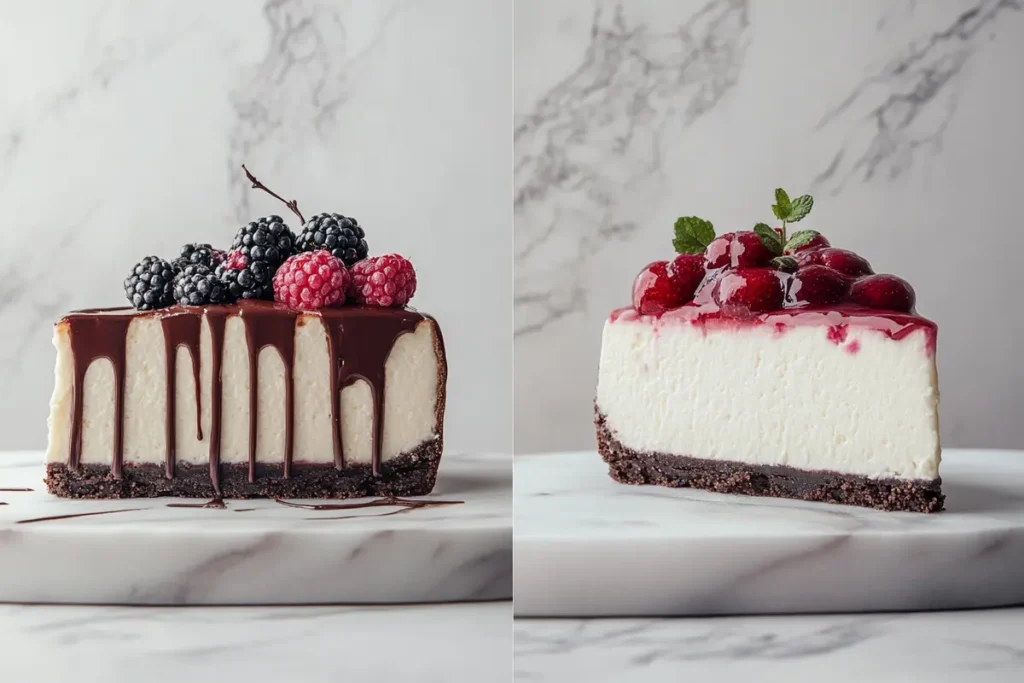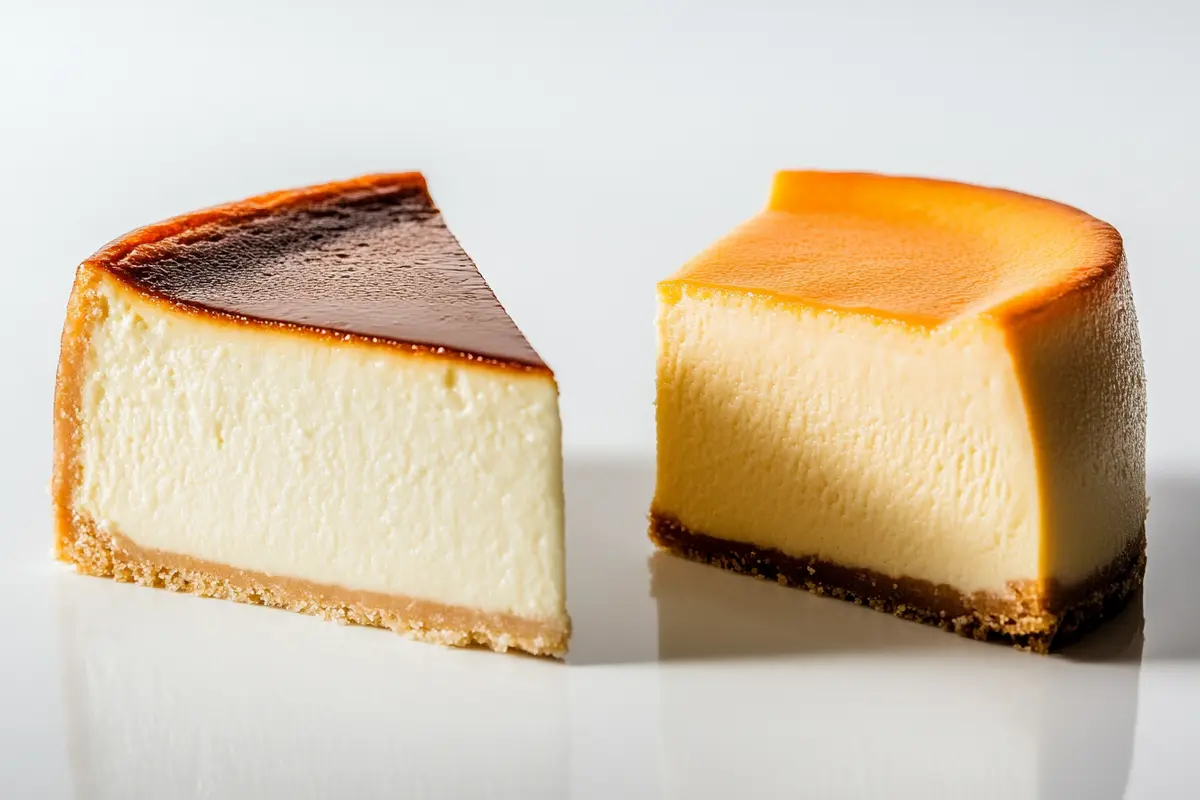Should cheesecake be dense or fluffy? This question often arises when bakers seek the ideal cheesecake texture. Cheesecake can range from firm and rich to airy and delicate. Therefore, understanding what influences density and fluffiness helps you achieve the perfect result. Many U.S.-based home bakers cherish cheesecake for its creamy indulgence. However, personal preference dictates whether you love it thick and velvety or soft and cloud-like.
Defining Cheesecake Texture: Dense vs. Fluffy
Cheesecake differs from many desserts because it balances creaminess with structure. Density often comes from a higher ratio of cream cheese to liquid and eggs. This creates a firm, rich, and luxurious dessert. On the other hand, fluffiness emerges when incorporating more air. Techniques like whipping cream cheese until light or folding in whipped cream can produce a lighter feel. Thus, when deciding Should cheesecake be dense or fluffy?, you must consider how you manipulate your ingredients and methods.
In a dense cheesecake, each bite feels rich and thick. This style often includes minimal air incorporation and may rely on classic New York recipes. By contrast, a fluffy cheesecake feels lighter. Air trapped inside the mixture creates a delicate texture. Such cheesecakes often use sour cream or whipped cream and sometimes even separated eggs to achieve a softer consistency. Your choice depends on whether you crave a substantial, almost custard-like treat or something airy and subtle.
Moreover, consider sweetness and flavor intensity. Dense cheesecakes can concentrate flavors. Fluffy ones may highlight subtler notes. If you add vanilla, lemon, or chocolate, a dense cheesecake can showcase these flavors powerfully. Meanwhile, a fluffy cheesecake might present them gently. By understanding these nuances, you gain control over your final dessert’s experience.
Key Ingredients That Influence Texture
- Cream Cheese: This ingredient defines cheesecake flavor and texture. High-quality, full-fat cream cheese often yields a denser, richer cheesecake. Lower-fat versions contain more water, potentially creating a softer result. For a fluffier cake, you might blend cream cheese with mascarpone or ricotta, both of which offer lighter textures.
- Eggs: Eggs provide structure and binding. More eggs can produce a firmer texture, while fewer eggs might allow a lighter feel. Beating eggs less vigorously helps maintain density, while carefully incorporating beaten egg whites or whipped eggs can introduce air for fluffiness.
- Sweeteners: Sugar not only sweetens but also affects moisture. More sugar can slightly soften the final texture. However, adding too much sugar may prevent the cheesecake from setting firmly. If you seek fluffiness, adjusting the sugar ratio or adding a small amount of liquid sweetener can influence consistency.
- Dairy Additions: Ingredients like sour cream, heavy cream, or yogurt contribute moisture and lightness. Sour cream, in particular, can soften the density of a classic cheesecake. Whipped cream folded into the batter before baking can create a mousse-like consistency, helping you achieve a fluffier texture.
Techniques for Achieving Density
Should cheesecake be dense or fluffy? If you lean toward dense, adopt certain techniques:
- Minimal Air Incorporation: Mix ingredients slowly and avoid whipping in too much air. Overmixing introduces bubbles that lead to a fluffier texture. Use a gentle, low-speed blending method.
- Room-Temperature Ingredients: Cream cheese at room temperature blends more smoothly, reducing the need for vigorous mixing. Less mixing means fewer air pockets, promoting density.
- Higher Ratio of Cream Cheese: Increase cream cheese compared to sour cream or other liquids. This shift makes the final mixture richer and heavier, resulting in a dense texture.
- Baking at Lower Heat for Longer: A slow, gentle bake at a lower temperature helps the cheesecake set gradually. This method encourages a dense, velvety crumb without becoming airy.

Techniques for Achieving Fluffiness
If fluffiness attracts you, follow these strategies:
- Whip Cream Cheese or Cream: Beating cream cheese until light and adding whipped cream or whipped egg whites can introduce air into the batter, yielding a lighter texture.
- Use Sour Cream or Yogurt: Replacing part of the cream cheese with sour cream can soften the structure. This substitution leads to a gentler mouthfeel.
- Fold Gently: If you incorporate whipped cream or egg whites, fold them in gently. Harsh stirring deflates the foam. Gentle folding preserves air bubbles, ensuring a fluffy cake.
- Consider Water Bath Baking: A water bath, also known as a bain-marie, provides even heat distribution. While commonly used to prevent cracks, it can also keep the cheesecake moist and slightly lighter. The steady humidity environment supports a softer set.

The Role of Eggs in Texture
Eggs matter significantly when answering Should cheesecake be dense or fluffy? Eggs contain protein that sets when heated, providing structure. More eggs create a firmer, denser cake, while fewer or carefully handled eggs lead to a lighter one.
For density, follow a standard recipe ratio. For fluffiness, try reducing the number of eggs slightly or experiment with separating yolks and whites. Whipping egg whites to stiff peaks and folding them in at the end introduces air, resulting in a airy cheesecake. However, proceed with caution, as adding whipped egg whites changes the classic cheesecake’s nature, edging it closer to a soufflé.
Remember that eggs also influence flavor. Too many eggs can produce an eggy taste. If you want a dense cheesecake without an overpowering egg flavor, balance your egg count carefully. For a fluffy cheesecake, using fewer eggs or combining them with lighter dairy elements can achieve the right texture and flavor balance.
Balancing Flavor and Texture
When deciding Should cheesecake be dense or fluffy?, think about flavor intensity. Dense cheesecakes can feel more decadent, allowing bold flavors to shine. Rich chocolate or caramel cheesecakes often benefit from density. Their thick texture complements intense, sweet tastes.
On the other hand, fruit-based cheesecakes might suit a fluffier texture. A lemon or strawberry cheesecake with an airy interior feels refreshing and light. The delicate structure allows subtle fruit flavors to stand out. Therefore, if you’re experimenting with new flavor combinations, adjust the texture to enhance the chosen profile.
Also consider sweetness levels. A sweeter cheesecake may benefit from fluffiness, preventing it from feeling heavy. Meanwhile, a denser cheesecake with moderate sweetness can deliver a luxurious dessert that satisfies cravings without becoming cloying.

Serving and Pairing Suggestions
Texture influences not only the cheesecake itself but also how you serve and pair it. A dense cheesecake might call for a small slice, served with a simple topping like fresh berries or a fruit compote. Its richness can stand alone with minimal adornment.
In contrast, a fluffy cheesecake pairs nicely with whipped cream or a light fruit sauce. The airy texture balances well with delicate flavors. If your cheesecake leans fluffy, consider pairing it with herbal teas or light sparkling beverages. The combination creates a refreshing dessert experience.
For dense cheesecakes, robust coffee or espresso can complement the richness. Alternatively, a dessert wine or rich liqueur can highlight indulgent notes. By matching beverages and toppings to your cheesecake’s texture, you elevate the overall enjoyment.
Controlling Moisture for Desired Texture
Moisture content plays a pivotal role in achieving your desired cheesecake texture. For density, limit excess liquid. Drain ingredients like ricotta well if using them. Avoid adding too much sour cream if you crave a dense structure.
For fluffiness, a bit more moisture can help. Add a splash of heavy cream or fold in whipped cream. Moisture helps aeration and keeps the crumb tender. Just remember not to make the batter too runny. Excess liquid may prevent proper setting, resulting in a cheesecake that refuses to slice cleanly.
Monitoring moisture also means paying attention to baking time. A slightly underbaked cheesecake can retain moisture, feeling more delicate. A slightly longer bake can drive off extra moisture, producing a denser result. Small adjustments in baking time help fine-tune texture to perfection.
Perfecting the Baking Process
Baking technique matters almost as much as ingredients. Should cheesecake be dense or fluffy? Either way, careful baking ensures the best outcome.
- Use a Water Bath: This method evens out heat distribution, preventing sudden temperature spikes. It also adds moisture to the oven environment. While water baths commonly prevent cracks, they can also influence texture. A humid environment encourages a softer, more uniform set.
- Check Doneness Early: Insert a gentle jiggle test. When the center wobbles slightly but the edges are set, remove the cheesecake. Overbaking can lead to dryness and density, while underbaking can mean too much softness. Perfect timing aligns with your texture goal.
- Gradual Cooling: Sudden temperature changes can cause cracks or unwanted firmness. Let your cheesecake cool slowly in a turned-off oven before moving it to the fridge. This gentle transition can preserve a smoother texture.
Ingredient Quality and Freshness
Fresh, high-quality ingredients influence cheesecake texture. Premium cream cheese with consistent fat content ensures predictability. Fresh eggs whip up more reliably, whether you need stable meringue for fluffiness or just solid structure.
Stale or low-quality ingredients can yield inconsistent textures. Cream cheese with too much water can soften the cheesecake more than intended, while low-quality eggs might not whip or emulsify as well. Investing in good ingredients pays off when you want to control texture precisely.
Also consider seasonal variations. Warm kitchen temperatures can soften cream cheese faster, influencing mixing. A cooler kitchen might require slightly longer whipping times for fluffiness. Stay attuned to these factors, adjusting your process as needed.
Exploring Different Cheesecake Styles
Cheesecakes come in many forms. Should cheesecake be dense or fluffy? Explore various styles to find your favorite:
- New York-Style: Dense, rich, and indulgent. Perfect for intense flavors and a classic experience.
- Japanese Cotton Cheesecake: Ultra-fluffy, light, and airy. Ideal for those who prefer a delicate, cloud-like dessert.
- Italian-Style (Ricotta Cheesecake): Can lean either way. Ricotta imparts a softer texture, often landing somewhere between dense and fluffy.
- No-Bake Cheesecake: Often fluffier due to whipped cream and gelatin stabilization. These rely less on eggs and baking.
Experimenting with global cheesecake traditions offers insight into achieving the perfect texture. Use their techniques as inspiration to refine your own style.
Presentation and Garnishing for Impact
Your cheesecake’s texture affects how it looks on the plate. A dense cheesecake may hold perfect edges, creating sharp, elegant slices. This firmness allows intricate toppings or neat fruit arrangements. A fluffy cheesecake may have softer edges that invite a more relaxed presentation.
For fluffy cheesecakes, consider dusting powdered sugar or adding a dollop of whipped cream. These delicate garnishes echo the cake’s lightness. For denser cheesecakes, dark chocolate curls, caramel drizzle, or a glossy fruit glaze create contrast, making each dense slice seem even more indulgent.
Remember, visual appeal complements texture. A dessert that looks as you intended heightens enjoyment. Thus, presentation aligns with your decision when asking Should cheesecake be dense or fluffy?
Storing and Freezing Considerations
Texture can change after storage. Dense cheesecakes often retain their structure well in the fridge or freezer. Fluffy cheesecakes, with their airy interior, might lose some loft after a day or two. Storing them covered and enjoying them fresh preserves the intended texture.
If you need to store a fluffy cheesecake longer, freeze it carefully. Wrap it tightly to prevent freezer burn. Thaw slowly in the refrigerator before serving to maintain as much fluffiness as possible.
Dense cheesecakes freeze well, making them great for prepping ahead of special occasions. Thawing doesn’t typically harm their rich texture. However, always test a small portion before committing a whole cake to freezing, ensuring the quality meets your standards.
Health Considerations and Textur
From a nutritional perspective, texture variations might reflect ingredient choices. Dense cheesecakes often contain more fat due to higher cream cheese content. Fluffy cheesecakes might rely on lighter dairy options or whipped cream, potentially affecting the calorie count.
If you prefer a lighter dessert, a fluffier cheesecake might feel less heavy. While not necessarily lower in calories, the perception of lightness may encourage smaller portions or balanced enjoyment.
Remember that cheesecake, dense or fluffy, remains an indulgence. Enjoy it in moderation, savoring its texture and flavor. Adjusting texture does not fundamentally change its richness, but can influence how satisfying each slice feels.
Embracing Personal Preference and Creativity
Ultimately, Should cheesecake be dense or fluffy? comes down to personal preference. Taste varies widely, and no single answer fits everyone. Embrace your preference and experiment until you find a recipe that truly delights you.
Feel free to break with tradition. If you love the idea of a half-fluffy, half-dense cheesecake hybrid, try blending techniques. Maybe start with a dense base and top it with a fluffy layer. Culinary creativity knows no bounds.
Your journey toward the ideal cheesecake texture transforms baking from a set of rules into an art form. Each adjustment teaches you more about how ingredients interact, guiding you closer to your personal perfection.
Frequently Asked Questions
What is the texture of cheesecake supposed to be?
Cheesecake texture varies, but it should be smooth, creamy, and pleasantly rich. Some prefer it dense and velvety, while others enjoy a lighter, fluffier mouthfeel. The ideal texture depends on personal preference and the techniques used in the recipe.
What consistency should a cheesecake be?
A cheesecake should hold its shape when sliced, but feel tender on the tongue. Whether it’s dense or fluffy, the consistency should remain creamy, not grainy. Aim for a uniform interior without lumps, cracks, or runny spots.
Why is my cheesecake not fluffy?
If your cheesecake lacks fluffiness, you might have incorporated less air into the batter. Overmixing at low speed or not adding whipped cream or beaten egg whites can reduce lightness. Adjusting ratios of cream cheese to lighter dairy or gently folding in airy components can help achieve a fluffier texture.

